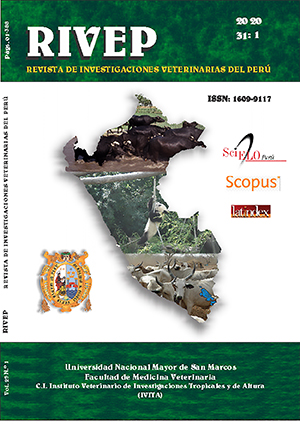Repellent effect of neem oil (Azadirachta indica A. Juss) against mosquitoes (Anophelex spp) in piglets
DOI:
https://doi.org/10.15381/rivep.v31i1.17544Keywords:
neem oil, stings, repellent for pigs, repellent efficiency, plant repellentsAbstract
The aim of this study was to evaluate the repellent efficacy for mosquitoes (Anophelex spp) of three doses of neem oil (Azadirachta indica A. Juss) in pigs under field conditions. The research was carried out at a time of year of abundance of mosquitoes in Tumbes, Peru. Forty recently weaned piglets were used, 10 per treatment, kept in indoor cages protected against mosquitoes. For the field test, four piglets per day were exposed randomly in external cages without protection to the mosquito (a different animal for each treatment per day) for 14 days over a period of two months. Neem oil was extracted with the soxhlet apparatus and the formula included 30% glycerin, 1, 2 or 3% neem oil (T1, T2, T3, respectively), and taken to 100% with pharmaceutical alcohol. A dose of 50 ml/piglet distributed throughout the body was applied. The bites and the number of mosquitoes were evaluated on four occasions of 15 minutes for three hours per day (06:15, 07:00, 07:45, 08:30) with intervals of 30 minutes of protection to the piglets. The mosquitoes biting the piglets (red abdomen) were collected using manual vacuum cleaners. The neem oil yield was 43.25 ± 1.64%. The percentage of repellency was 88.74 ± 37.8, 75.66 ± 122.8 and 52.27 ± 164.6% for T1, T2 and T3, respectively (p<0.05). The percentage of protection (repellent efficiency) was 93.92 ± 125.3, 85.71 ± 56.8 and 67.78 ± 13.4% for T1, T2 and T3, respectively (p<0.05). The average number of mosquitos in the control group, T0 (without repellent dose) was 365.54 ± 418 386 bites/day, being different (p<0.05) to the treated groups T1, T2 and T3 (49.98 ± 7940.15; 113.82 ± 40 382; 19.52 ± 1184 bites/day, respectively, and without significant difference between the treated groups. The Repellency Index (IR) for T1, T2 and T3 was 0.47, 0.24 and 0.10, respectively, which shows that the dose used in T3 showed a higher level of repellency and efficacy against mosquitoes.
Downloads
Downloads
Published
Issue
Section
License
Copyright (c) 2020 Andrea Llanos Gonzáles, Héctor Sánchez Suárez, Gloria Ochoa Mogollón, Tessy Peralta Ortiz, Alberto Ordinola-Zapata

This work is licensed under a Creative Commons Attribution-NonCommercial-ShareAlike 4.0 International License.
AUTHORS RETAIN THEIR RIGHTS:
a. Authors retain their trade mark rights and patent, and also on any process or procedure described in the article.
b. Authors retain their right to share, copy, distribute, perform and publicly communicate their article (eg, to place their article in an institutional repository or publish it in a book), with an acknowledgment of its initial publication in the Revista de Investigaciones Veterinarias del Perú (RIVEP).
c. Authors retain theirs right to make a subsequent publication of their work, to use the article or any part thereof (eg a compilation of his papers, lecture notes, thesis, or a book), always indicating the source of publication (the originator of the work, journal, volume, number and date).



